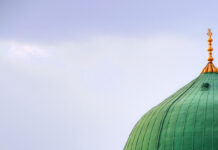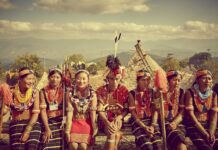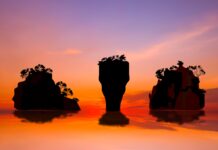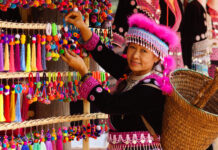Discover Asia’s vanishing traditional tattoos
Text & photos Lars Krutak
For centuries, indigenous tattooists working across Asia have marked human skin with powerful designs and symbols in their quest to signal ethnic identity and render the body sacred. Carried through life and onwards into death, these marks of humanity testify to an ancestral legacy that is in danger of gradually fading away.
The Marks of the Warrior
It’s early April on the India-Myanmar border and the Konyak Aoling festival is in full swing. Here in the village of Longwa, volleys of musket fire explode – pop, pop, pop – and clouds of heavy smoke interrupt the blue sky. Throngs of plumed, tattooed, and traditionally-garbed Konyak warriors jump, chant, and re-enact their former exploits on the battlefield in a concerted attempt to honour and attract the attention of Wangwan, their divine spirit of blessing.
Aoling is a new year celebration of sorts, marking the end of winter and the coming of the new agricultural year. All of the fields have been planted by now and the Konyak eagerly await the arrival of the rejuvenating rains. Through elaborate feasting they give thanks to all of those friends and relatives who provided them with assistance in the previous year, including the spirits of the ancestors. But above all, they celebrate and give praise to Wangwan until the six-day festival ends.
In bygone days, Aoling was also the time for tattooing boys and girls who reached adulthood. These ethnic markers were applied to various parts of the body by skilled female tattooists. Men who had participated in combat and who had taken a human life were entitled to unique tattoos, usually on the neck or face, which proclaimed their status in Naga society.

One of these men is Lalang, a striking Konyak elder who is now blind. He is uncertain of how old he is, but puts himself at around 90 years old. Despite his great age, he springs into combat mode with ease: crouching, tracking, circling, then thrusting his spear into the chest of his make-believe enemy. Once injured, his imagined victim is beheaded with a swift blow of his razor-sharp, machete-like sword or dao – a tool he has used to this purpose three times before the Naga stopped headhunting in the early 1960s.
Across the Naga region, April was a month for war. Able-bodied men were compelled to take human heads because they believed them to be a source of future prosperity. For the Naga, these macabre tokens were like containers of seed that, upon germination, could increase the fertility of the crops and of the men and women in the village community. In order to receive this life-giving power, village shamans performed rituals throughout the year to ‘please’ the heads, which eventually came to rest in men’s houses (morungs), caves, logdrums, or in sacred banyan tree groves that can sometimes still be seen in these remote villages.
Far above Longwa, along a lonely stretch of dirt road, lies a cluster of villages inhabited by the Chen Naga, who also celebrate the coming of spring. Originally a Myanmar tribe, men who have killed two or more enemies wear elaborate, geometric tattoos that completely cover their necks and upper chests. Apart from these village heroes are a handful of other marked men whose back tattoos are related to their spirit companions and guides – the tiger and the leopard.
Several Chen elders, usually old chiefs (anghs) or great warriors, bear these incredibly powerful designs. When these men sleep, it is believed that their soul travels out of their bodies and into that of their animal familiar. They can see through the eyes of their tiger or leopard counterpart, hear and smell what their animal companions encounter on the trail, and in the headhunting era, warriors could employ the help of their protector to track the movements of their enemies. Men who possessed these spiritual assistants would become tiger- or leopard-like in their actions, and were rarely defeated in battle.
But there were risks associated with having these feline doppelgangers. If your soul-animal was wounded or killed, then the human body connected to it would experience a similar fate. Also, if your companion had a very powerful spirit and you failed to control it, it was likely that you would become insane, and die.

Inspired by myth
Just as great Naga warriors were tattooed to mark their achievements in headhunting, so, too, where those of the Kalinga tribe in the northern Philippines. Here, amidst the rain soaked-mountains of the Central Cordillera range, lives the last generation of headhunters.
Before his passing, 90-plus year-old Lakay Miguel Fang-id explained that he earned his elaborate chest and back tattoos for inter-village combat before WWII, and owing to the Japanese heads he took during the early 1940s. Small tally marks behind his right ear represent his number of enemy engagements and the shield and spear pattern at the centre of his chest “blocked the path of my enemies”, he said.
The last Kalinga tattoo master, 98-year-old Whang-Od of Buscalan village, explained that her tattoos transform girls into women. These beautiful and intricate patterns are produced with batons made of bamboo or water buffalo horn tipped with mountain orange and other varieties of local citrus thorns. They are expertly hand-tapped into the skin.
Female Kalinga tattoo patterns are inspired by everyday objects and nature: rice bundles, rice terrace steps, bamboo shelves, woven grass mats, ferns, rattan fruit, a star or moon, and snake or centipede scales are used. The latter two designs are dominant in both men’s and women’s tattooing because of their significance in Kalinga myth. Whang-Od reported they were “friends of the warriors” (bulan ti mangayaw) because of the powerful omens they once delivered on the warpath.
Although missionaries compelled many tattooists to cease their work decades ago, Whang-od and her much younger apprentices continue to tattoo traditional Kalinga patterns. But today, her clientele is largely non-Kalinga in origin and includes flocks of domestic and foreign tourists who visit her village nearly every day throughout the year to be tattooed by a living legend.
She says, “If Kalinga tattooing stops, we will lose an important part of our culture that has been handed down from generation to generation. Whether it is shared among us or with outsiders, to us, it is our ancestors’ legacy, and it defines who we are as a people, so we must continue.”
Inked into the afterlife
Unlike Whang-Od, most of the indigenous tattoo artists living on the island of Borneo have not practiced in decades; missionaries compelled them to discard these cultural traditions in the 1950s. Nevertheless, several tattooed female elders recounted their experiences and described the elaborate ceremonial practice once attached to this ancient tradition.
Before Kayan tribal tattooing was eliminated, women believed that tattoo designs acted as torches after death, leading them through the darkness of the afterlife to the longhouses of their beloved ancestors.
Kayan tattooing was largely female-centric, although male warriors were tattooed, too. The process was a long and painful one, sometimes lasting as long as four years. Several elders explained the implications of flowing blood released during the rite. “It attracted evil spirits,” said former Kayan tattooist Ping Saram. “So there were prohibitions to regulate this.” For instance, girls could not be tattooed during menstruation or when a corpse was present in the village.
“Kayan tattooists worked under the tutelage and protection of two spirits,” said Hunyang Lisang, a female Kayan priest, or dayong. “They were invoked before any tattooing pattern was initiated for a female client. The prayer announced to the spirit which particular design was to be applied, and asked for the client to feel little pain and that the tattooist make beautiful designs.”
Kayan women were extensively tattooed on their hands, arms, feet, and legs. One of the most powerful tattoo motifs was the lukut, or bead design, resembling a star. This powerful tattoo was worn on the knuckles, wrists, or forearms and was believed to keep the soul from wandering away from its human host.

All but lost
The Mentawai of Siberut Island in Indonesia live some 2,300 kilometres west of Borneo, and are some of the most profusely tattooed indigenous people living today. The tattooing customs of the Mentawai are closely connected to their religious beliefs and their concept of the soul. Keeping the human soul in balance or harmony with the spirits that govern the world is a guiding principle in daily life. And one way to keep it ‘close’ is by beautifying the body with tattoos.
But Mentawai tattooing fulfills other functions. It allows one’s ancestors to recognise the deceased after death. Tattoos also serve to distinguish clans regionally, as each group employs unique identifying patterns.
Traditionally, tattoos were applied by a shaman (sikerei, translated as ‘one who has magic power’), but their numbers are steadily declining. In turn, Mentawai tattooing practices are gradually being discarded. Some youths complain that they cannot locate experienced artists; others say because Indonesia is an Islamic country, tattooing is taboo given associations with religious impurity and criminality.
“The younger generation no longer want to get their bodies tattooed,” says shaman Aman Lau Lau, who still dons a traditional loin cloth. “They’ve travelled to the end of the river, and they’ve seen people wearing T-shirts, shoes, and modern clothes. And they want a modern lifestyle, too. So they are leaving our tattoos behind.”
Old Hands, New Ink
Thinking of getting a traditional-style tattoo in Asia? Here are five recommended tattoo artists who are keeping their traditions alive.
- Age Old Experience
Home to the world’s oldest practicing tribal tattoo artist, this Kalinga village, Buscalan, on the island of Luzon, is set amidst ancient rice terraces with commanding views of the Cordillera Mountains with the Chico River Valley below. At 97, Whang-Od Oggay and her much younger tattoo apprentices Grace and Ilyan apply various traditional patterns through the traditional technique of hand-tapping. You will need to make the trek to the rustic village, but many families operate homestays for the intrepid visitor.
- Preserving Tradition
Opened in 2016, Godna Gram, a state-of-the-art tattoo studio and research centre, was founded by one of India’s most talented tattoo artists, Moranngam Khaling (known as Mo Naga). A member of the Uipo Naga tribe, Khaling has dedicated his career to the preservation of ethnic Indian tattoo traditions, especially those of the various Naga tribes of India and Myanmar. Godna Gram offers hand-poking, hand-tapping, and machine tattooing. Through special arrangement, Khaling also offers traditional tattooing in his home village of Khangshim in Manipur state.
- An Artist’s Touch
Herpianto Hendra of Folk Tattoo was born and raised in the Iban tribal region of West Kalimantan. As a graduate of the prestigious Indonesian Institute of the Arts, he is a qualified artist and a self-taught tattooist and specialises in traditional hand-tapped Indonesian tribal tattoos.
While you’re at it, Yogyakarta is a fantastic point from which to visit the magnificent ancient ruins of Borobudur, a UNESCO World Heritage Site, which is convenientlylocated about one-hour north of the city.
- Winning Design
Ernesto Kalum from Borneo Headhunter Tattoo is an ethnic Iban tattooist and founder of one of Sarawak’s oldest professional tattoo studios. He is an accomplished, award-winning traditional tattooist who mastered the art of hand-tapping more than 20 years ago. Kalum and his staff aim to promote and preserve the rich art form of Iban pantang (tattooing) and other tribal tattooing traditions of Borneo.
- Bold Beauty
Taku Oshima from Tribal Tattoo Apocaript has been machine tattooing for nearly 20 years and is widely considered to be among one of the very best tattooists working in Asia today. Renowned for his strikingly bold blackwork styles, his influences include Indian Mehndi (henna), Polynesian, and indigenous Borneo and Japanese designs. Oshima firmly believes tattooing is a spiritual act and strives to bring out one’s inner soul though his award-winning designs.
For more stories and photos, check out Asian Geographic Issue 121.











